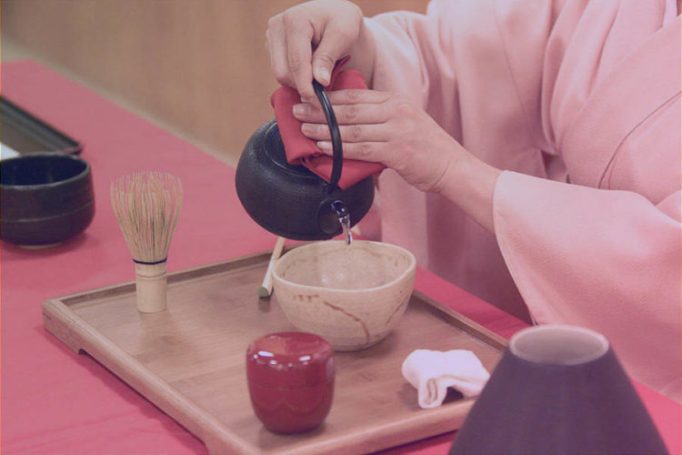Mieszkaniec Los Angeles, Mark Umbriaco, zawsze szuka okazji, aby doświadczyć nowego fragmentu kulturowego mozaiki swojego miasta. Kiedy więc on i jego przyjaciel zauważyli możliwość uczestnictwa w japońskiej ceremonii parzenia herbaty na festiwalu sztuki 15 lat temu, nie wahał się.
Zajęli miejsca na sali i zdobyli jedyne wolne miejsca — z przodu, obok życzliwego staruszka w kimonie. „I wszyscy trochę spanikowali,” wspomina Umbriaco.
Do tego dnia jedynym doświadczeniem Umbriaco związanych z zawiłymi rytuałami serwowania zielonej herbaty matcha było spojrzenie
do pawilonu japońskiego w SeaWorld San Diego jako dziecko w latach 70.
Nie mógł więc wiedzieć, że właśnie wcielił się w delikatną sztukę, przesiąkniętą kulturową tradycją honoru i szacunku, która określała wszystko, od sposobu trzymania misy na herbatę, po to, gdzie siedzieć i co mówić. Ani też tego, że mężczyzna w kimono to mistrz herbaty Hounsai, szef jednej z czołowych szkół herbaty i część wpływowej rodziny w Japonii.
„Był bardzo gościnnym, bardzo wytwornym starszym panem,” mówi Umbriaco. Wybaczając naruszenie etykiety, Hounsai przyjął nowo przybyłych. „Był po prostu tak sympatyczną, życzliwą, zaangażowaną, obecną osobą, że wyszedłem stamtąd z myślą: 'Co to jest?’ Byłem naprawdę pod wrażeniem.”
Chcąc dowiedzieć się więcej o filozofii i praktyce parzenia herbaty, Umbriaco zwrócił się do sensei w Urasenke Tankokai L.A. Association.
Mająca swoją siedzibę w Kioto, Japonia, ta organizacja z ponad 400-letnią historią rozciąga się na cały świat z oddziałami od Europy po Peru,
ucząc Drogi Herbaty i dzieląc się przyjaźnią, która jednocześnie celebruje i przekracza japońską kulturę.
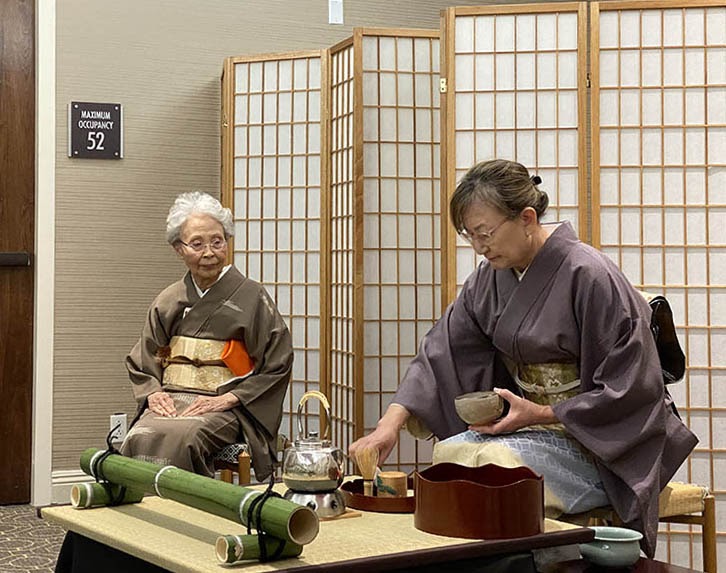
Umbriaco jest ustępującym menedżerem anglojęzycznych studentów w stowarzyszeniu, gdzie członkowie ćwiczą, uczą się i uczą sztuki japońskiej herbaty. Większość członków, jak wyjaśnia Umbriaco, to japońscy ekspaci — ale jest rosnąca liczba studentów, którzy nie mówią po japońsku, i ta grupa jest tak różnorodna jak sam Los Angeles.
Herbaciarnia korzysta z DreamHost do obsługi swojej obecności online, co stanowi platformę do przełamywania barier kulturowych i językowych w celu przekazania praktyki nowemu pokoleniu.
„Członkowie, którzy są Japończykami, starzeją się, a praktyka picia herbaty jest żywą formą sztuki,” mówi Umbriaco. „I aby mogła istnieć, zwłaszcza w miejscach, gdzie zmiany są największe, muszą przyciągnąć znacznie więcej osób, a internet jest miejscem, w którym można to zrobić.”
Droga Herbaty — Praktyczne Doświadczenie
Tłumaczone z japońskiego, chado oznacza drogę lub praktykę picia herbaty. Japońskie ceremonie herbaciane —
lub dokładniej, praktyki związane z herbatą — to coś więcej niż tylko wspólne picie napoju. Praktykowanie ceremonii herbacianej to wyraz kultury, forma sztuki, która łączy uczestników i zmusza ich do skupienia się na obecnym momencie.
„Istnieją bardzo krótkie ceremonie, które trwają 10 minut, a całkowite wyrażenie wydarzenia z herbatą zajmuje ponad cztery
godziny, prawie pięć godzin, aby je wykonać,” mówi Umbriaco, który uczył się u tego samego sensei przez 15 lat.
Herbata może zabrać lata nauki i całe życie, aby ją opanować.
Praktyka ma prosty schemat: Rozpoczyna się od oczyszczenia narzędzi do herbaty i kontynuuje przez przygotowanie i podanie słodyczy oraz zielonej herbaty, a kończy na sprzątaniu i zakończeniu. Ci, którzy praktykują herbatę, muszą stać się mistrzami etykiety. Nawet najmniejsze ruchy są regulowane przez tradycję, a uczestnicy zachowują spokojne tempo i postawę, szanując zaszczytne role gości i gospodarza.
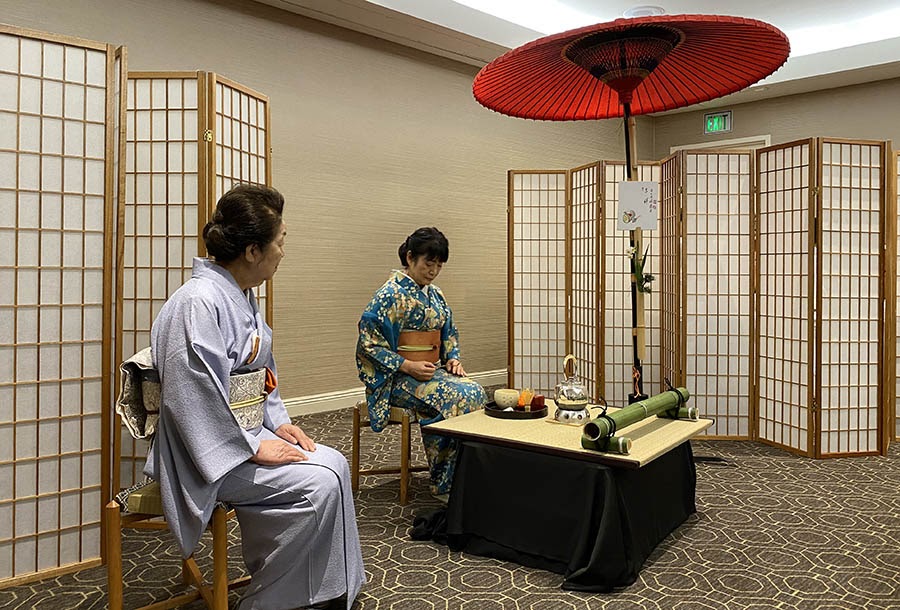
„Herbata to dziwne zwierzę,” mówi Umbriaco. „Pochodzi z buddyzmu zen, więc można znaleźć w niej wiele elementów zen.
Oczyszczamy umysł, ciało i narzędzia, zanim zrobimy herbatę. Gdy wchodzisz w przestrzeń herbaty, ma to być
inna przestrzeń; zdejmujesz kurz z trosk świata zewnętrznego i wchodzisz
w przestrzeń, gdzie wszyscy ludzie są tacy sami. Nikt nie jest wyżej od innej osoby w pokoju herbacianym.”
Poza zasadami i etykietą, praktycy herbaty muszą opanować uważność, świadomość ulotnej chwili.
Mają powiedzenie w herbaty: „jeden raz, tylko raz.” Nie ma znaczenia, jak długa lub krótka jest ceremonia, zdarzy się
tylko raz. Niezależnie od tego, jak bardzo się starasz, po prostu nie możesz odtworzyć chwili.
Umbriaco wyjaśnia: „Czas będzie inny. Data będzie inna. Twoje nastawienie będzie inne. Kwiaty będą inne. Jedzenie smakuje inaczej. Temperatura będzie inna. To sięga do zenowskich korzeni herbaty: Niezależnie od tego, jak jest skomplikowana i doskonała, zdarzy się tylko raz, i musisz być obecny.”
Oprócz swoich duchowych korzeni, „herbata jest również głęboko zakorzeniona w świeckiej kulturze japońskiej, dlatego istnieje wiele, wiele
zasad,” mówi Umbriaco. „Powinienem móc pójść na wydarzenie związane z herbatą w dowolnym miejscu na świecie i spodziewać się, że dokładnie
wiem, co się wydarzy. Kiedy wchodzisz w tę przestrzeń herbaty, jakby tracisz siebie. Fizycznie i kulturowo. A potem
wszyscy się jednoczą. Nie ma znaczenia, jakim językiem mówisz ani skąd pochodzisz.”
Powiązane: Ten użytkownik DreamHost ratuje świat — jedno ziarno na raz
Przekraczanie Praktyk Kulturowych
Sposób parzenia herbaty nie może być przyswojony z książki czy w klasie — musi być przekazywany z osoby na osobę, od sensei do ucznia. „Powinieneś oczekiwać, że będziesz z twoim sensei przez bardzo, bardzo długi czas,” mówi Umbriaco. „Ten sensei ma swojego sensei, a tamten sensei ma również swojego sensei. Istnieje linia starożytnej edukacji przekazywanej z osoby na osobę.”
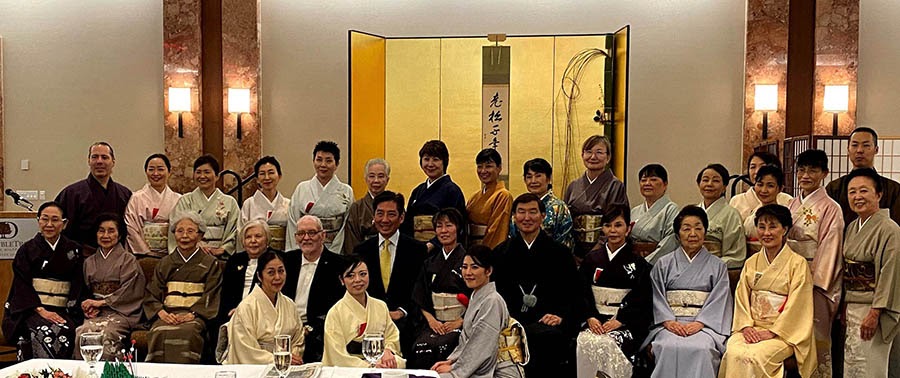
Kilka szkół herbaty zostało założonych w Japonii setki lat temu, aby ułatwić to uczenie się i połączyć senseis
ze studentami i zasobami. Obejmuje to szkołę Urasenke Tankokai, kierowaną przez rodzinę Senke. Szkoła ta, w
szczególności, zobowiązuje swoje oddziały na całym świecie, w tym Stowarzyszenie Urasenke Tankokai L.A., do dzielenia się
praktyką herbaty.
Po II wojnie światowej, Honensai — mistrz herbaty, który gościnnie przyjął Umbriaco na jego pierwszą ceremonię herbaty — przewodził
w rozszerzaniu herbaty poza granice Japonii. „Uważał herbatę za sposób na wyrażenie gotowości Japonii do bycia siłą pokoju,
a nie wojny, jak to było wcześniej,” wyjaśnia Umbriaco. „Dokładał wielkich starań, aby rozpowszechnić herbatę na całym świecie.
Jest prawdopodobnie najlepszym ambasadorem herbaty w jej całej historii.”
Honensai streścił cel szkoły w jednym zdaniu: „spokój poprzez filiżankę herbaty.”
Z tym stwierdzeniem mistrzowie herbaty założyli stowarzyszenia na całym świecie, docierając do Los Angeles około 60 lat temu. „I stąd to tylko rosło,” mówi Umbriaco. „Ta wiadomość o pokoju rezonuje z wieloma ludźmi.”
Praktyka picia herbaty jest najbardziej rozpowszechniona w regionach z dużą liczbą japońskich ekspatriantów, w tym w Południowej Kalifornii
i San Francisco. Jednak Umbriaco uczestniczył w ceremonii herbaty w takich miejscach jak Teksas i Środkowy Zachód, lokalizacje z większą
liczbą amerykańskich praktykujących niż Japończyków.
Chado i picie herbaty w Los Angeles
Dzisiaj, Stowarzyszenie Urasenke Tankokai L.A. liczy głównie członków japońskich, ale liczba osób nie mówiących po japońsku w stowarzyszeniu stale rośnie.
„L.A. to miejsce o dużej gęstości zaludnienia,
wielokulturowe,” mówi Umbriaco. „A herbata stała się częścią tego. Piłem herbatę w Los Angeles od
kobiet w hidżabach. I ćwiczyłem z ludźmi z Afryki, Włoch, Ameryki Południowej, Meksyku i wszystkich miejsc w
Ameryce Północnej. Więc to faktycznie odzwierciedla populację i ludzi, którzy są w tym regionie.”
Stowarzyszenie Urasenke Tankokai L.A. pełni funkcję klubu towarzyskiego, w którym członkowie spotykają się, aby ćwiczyć ceremonię parzenia herbaty, jak również stanowi punkt połączeniowy i miejsce nauki dla sensei i ucznia. Jak w przypadku każdej edukacji i wyrazu artystycznego, praktyka parzenia herbaty nie jest tania — słodycze, zielony proszek do herbaty matcha oraz wykonane narzędzia mają swoją cenę, a wszystko, co sensei zarabia na nauczaniu, jest reinwestowane w praktykę parzenia herbaty. Stowarzyszenie zapewnia praktykującym dostęp do narzędzi do herbaty, które inaczej mogłyby być poza ich zasięgiem cenowym.
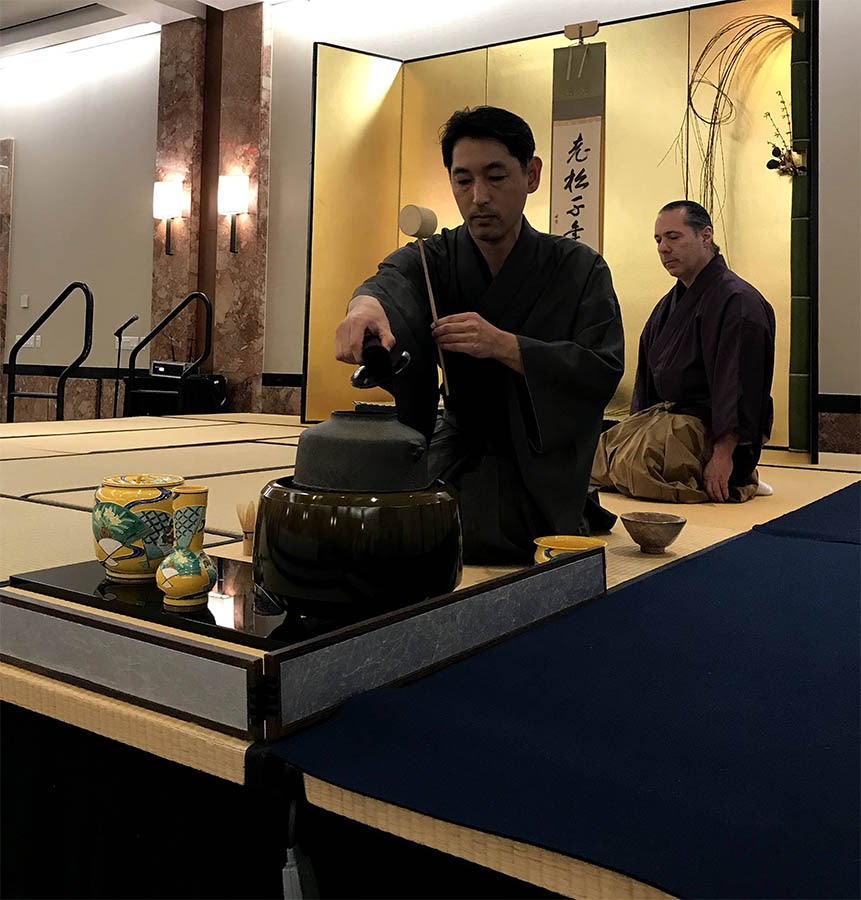
Zgodnie z ich misją dzielenia się drogą herbaty oraz promowania „spokoju poprzez miseczkę herbaty”, członkowie stowarzyszenia
przeprowadzają pokazy w herbaciarni oraz na wydarzeniach kulturalnych w całej Południowej Kalifornii. Herbata, mówi Umbriaco,
jest wizualnym sposobem na dzielenie się i reprezentowanie japońskiej kultury. Celem pokazów herbacianych jest zaproszenie nowych osób,
aby przyszły, zobaczyły i dołączyły — tak jak mistrz herbaty Hounsai powitał Umbriaco — oraz wyodrębnienie fragmentu japońskiej kultury
w różnorodnym krajobrazie Los Angeles.
Najbardziej rozbudowane ceremonie przyciągają i celebrują najlepsze przykłady japońskiej sztuki.
„Uważa się to za bardzo wyjątkowe wydarzenie, na które składa się niemal każda dostępna w Japonii forma artystyczna,” tłumaczy Umbriaco. „Podczas tego wydarzenia zakładasz swój najlepszy kimono. Doświadczasz najlepszej kaligrafii. Doświadczasz najlepszego jedzenia, najlepszego sake, najlepszej herbaty, najlepszych manier; najlepsze, co Japonia ma do zaoferowania, jest zawarte w najdłuższych wydarzeniach, a nawet dla Japończyków to rzadka i bardzo wyjątkowa rzecz.”
Powiązane: Poznaj Museum Hack: Wycieczki dla osób, które nie lubią muzeów
Liście herbaty i dynamiczna strona internetowa
Sztuka żywa o starożytnych korzeniach potrzebuje dynamicznej strony internetowej, która sięga przez różne kultury. Dlatego
Stowarzyszenie Urasenke Tankokai L.A. wybrało DreamHost shared web hosting i WordPress do
zasilania swojej obecności online. Shared Hosting pozwolił stowarzyszeniu zaistnieć w internecie z zainstalowanym WordPress, oferując
wolność tworzenia pięknej, spersonalizowanej strony internetowej, która jest prosta w utrzymaniu i nawigacji, niezależnie od języka, którym
mówisz.
„To piękna strona internetowa, która była
łatwa do skonstruowania i użytkowania przez osoby, które nie mówią po angielsku jako pierwszym języku; osoby w naszym
stowarzyszeniu mogą z niej korzystać i ufać, że spełni ich oczekiwania,” mówi Umbriaco.
I ich zamierzeni czytelnicy: Amerykanie i ekspaci, którzy szukają miejsca w L.A., by dowiedzieć się więcej o herbacie.
„Jest wielu młodych ludzi na studiach, którzy są zainteresowani światową kulturą lub kulturą japońską, albo uczą się japońskiego. Mogą nas znaleźć przez stronę internetową; to, co ludzie szukający herbaty w Los Angeles zobaczą.”
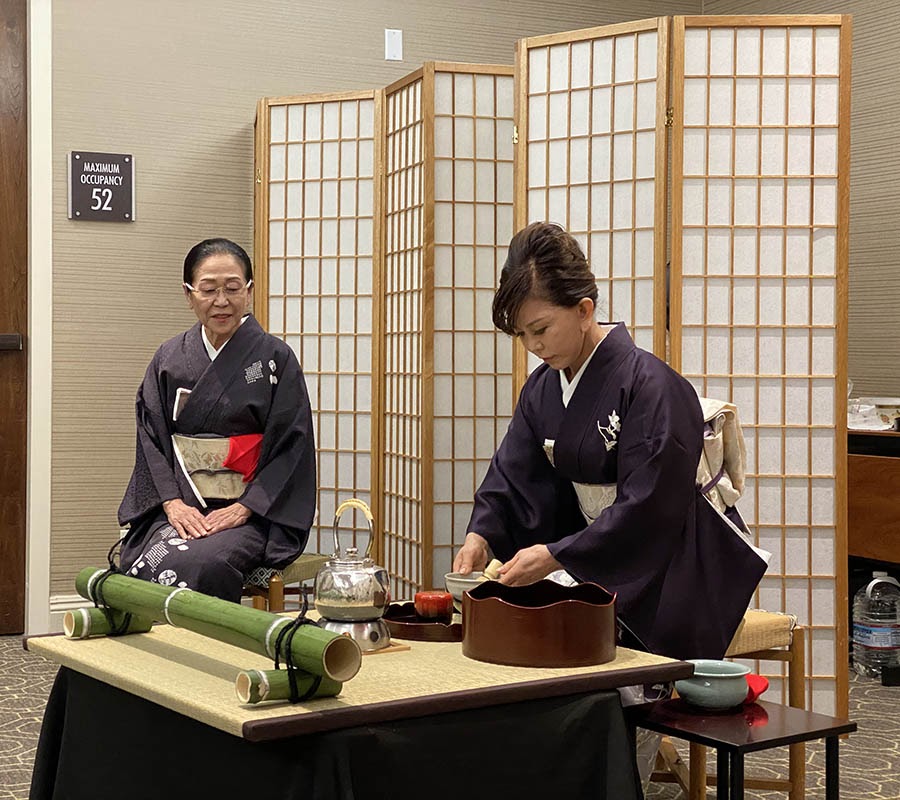
Jest dumny ze strony internetowej i jej roli w uczynieniu starożytnej formy sztuki istotnej dla współczesnych odbiorców.
„Herbata jest stara; istnieje od dawna,” mówi Umbriaco. „Herbata to także żywa forma sztuki. I nie ma w niej nic martwego. To przywództwo rodziny Senke i liderów herbaty. Ale aby była aktualna, musi być współczesna. Możesz mówić o pokoju ile chcesz. Ale jeśli ludzie nie wiedzą, to nie jest to aktualne.”
Sztuka, która promuje i praktykuje pokój, a także uważność i szacunek dla teraźniejszości, jest zawsze aktualna,
bez względu na to, gdzie się znajdujesz lub kim jesteś.
„Odwiedź Los Angeles i wypij z nami herbatę,” dodaje Umbriaco. „Herbata ma coś dla każdego, pod warunkiem że jesteś gotów praktykować uważność i być obecnym.”
Zdjęcie główne autorstwa Georges Seguin, rozpowszechniane na licencji Creative Commons Atrybucja-Udzielnienie na tych samych warunkach 3.0 Nieograniczona.
